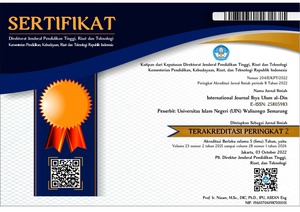The Mainstreaming Policy of Religious Moderation Education in West Sulawesi Province
DOI:
https://doi.org/10.21580/ihya.25.1.14150Keywords:
Perspective, Education, Moderation, Nationality, ToleranceAbstract
This research is oriented to describe and elaborate on the mainstreaming policy of religious moderation on education in West Sulawesi Province, which the government is currently reviewing through the Ministry of Religion Affairs. The study conducted qualitative methods with specific data collection. It analyzed the instruments and found that the informants, consisting of educators and religious figures, deeply understood religious moderation based on the al-Qur'an and hadith, which emphasized Islam as a moderate religion. The principle of restraint (Wasathiyyah) in Islam is, in fact, equivalent to the direction or value of religious moderation programmed by the current government. Then, religious moderation is to be implemented in education. In that case, some components should be prepared carefully to avoid overlapping or duplicating with other programs. For example, several implementation models, with their respective advantages and disadvantages, include autonomous, integrative, collaborative, and enrichment models in education. In addition, what is also very urgent to formulate is the right curriculum, tools and learning designs, and competencies of educators, including an assessment tool which, of course, is more oriented towards attitudes and behavior no longer trapped in the pathology of learning that has been ongoing, more focused on fulfilling the cognitive domain.
Downloads
References
Arraiyyah, Muhammad Hamdar. 2020. “Five Levels of Teaching and Learning the Holy Qur’an.” In International Joint Conference on Arts and Humanities (IJCAH 2020), Atlantis Press: 331–37.
Arsyad, Azhar. 2019. Media Pembelajaran (Edisi Revisi). Jakarta: Raja Grafindo Persada.
Davis, Barbara Gross. 2009. Tools for Teaching. New Jersey: John Wiley & Sons.
Dickey, Walter, and L Carey. 2015. The Systematic Design of Instruction. New Jersey: Pearson.
Lickona, Thomas. 1999. “Character Education: Seven Crucial Issues.” Action in Teacher Education Vol. 20(No. 4): 77–84.
LIPI. 2018. “LIPI: Intoleransi Keagamaan Lahan Subur Terorisme.” http://lipi.go.id/lipimedia/lipi:-intoleransi-keagamaan-lahan-subur-terorisme/20615.
Madjid, Nurcholish. 2019. Khazanah Intelektual Islam. Jakarta: Yayasan Pustaka Obor Indonesia.
Matola, Muhammad Ghalib et al. 2020. Berislam di Jalur Tengah: Dinamika Pemikiran Keislaman dan Keindonesiaan Kontemporer. Yogyakarta: IRCiSoD.
Maulana, Dirga. 2019. “Ruang Moderasi Beragama.” https://mediaindonesia.com/opini/211781/ruang-moderasi-beragama.html.
PPIM. 2018. Policy Brief Ancaman Radikalisme di Sekolah. Jakarta: PPIM UIN Jakarta.
Rama, Bahaking. 2020. “Perspektif Sosio-Historis tentang Menata ke Depan Keunggulan Pendidikan Islam.” Al-Musannif Vol. 2(No. 1): 1–14.
Republik Indonesia. 2012. Undang-Undang Republik Indonesia Nomor 12 Tahun 2012 tentang Pendidikan Tinggi. Jakarta: Sekretariat Negara.
———. 2017. Peraturan Presiden Republik Indonesia Nomor 87 Tahun 2017 tentang Penguatan Pendidikan Karakter. Jakarta: Pemerintah Republik Indonesia.
Rofiq, Ahmad Choirul. 2020. “Ideal Relationship between Pancasila and Indonesian Muslims.” Aristo Vol. 8(No. 2): 274–96.
Setara Institute. 2015. “Setara Institute Luncurkan Indeks Kota Toleran 2015.” http://setara-institute.org/setara-institute-luncurkan-indeks-kota-toleran-2015/.
Wahid Foundation. 2016. Potensi Intoleransi dan Radikalisme Sosial Keagamaan di Kalangan Muslim Indonesia. Jakarta: Wahid Foundation & Lembaga Survei Indonesia.
Yaumi, Muhammad. 2014. Pendidikan Karakter: Landasan, Pilar dan Implementasi. Jakarta: Prenada Media Group.
Yaumi, Muhammad, and Rustam Husain. 2015. “Character Education Values that Work in Islamic Senior High School Setting.” Al-Ulum Vol. 15(No. 2): 319–34.
Downloads
Published
How to Cite
Issue
Section
License
By submitting an article to the journal, the author(s) agree to transfer the published article's copyright to the journal, which will act as the publisher. This means the journal will have the right to publish the article in various forms, including reprints. The journal will maintain the publishing rights to the published articles.
This work is licensed under Creative Commons Attribution-ShareAlike 4.0 International License.
In line with the license, authors and third parties (readers, researchers, and others) are allowed to share and adapt the material. In addition, the material must be given appropriate credit, provided with a link to the license, and indicated if changes were made. If authors remix, transform or build upon the material, authors must distribute their contributions under the same license as the original.



